The Growth Of Countryside Charter, A Fiscally Conservative Charter School In Michigan
My kids have attended Countryside Charter School located in Benton Township, MI since my oldest started Young 5s in 2008. This was the first charter school in our county and has seen extraordinary growth since it first held classes in 1997. Last week Countryside opened its new Elementary building which is being paid for from operating funds.
the new facility is very impressive and exactly as described when the project was first launched. The building has 19 classrooms, a music room, a full service cafeteria (Countryside has always brought in food from an outside service), and 6 small “pod” rooms for things like reading intervention. The building also has a conference room, teachers lounge, and offices for the Principal and Admin. Another cool addition for this building is that there is a room off of the main office for sick kids to wait to be picked up in, allowing the administration staff to have some separation.
This school was built right next to the main campus and cost a total of $9 million. Think about this compared to some of the bond issues that other school districts have recently asked for. Nearby St. Joseph Public Schools just asked voters for $98 Million. Then remember this: Charter schools receive $0 from property taxes. This building is funded from the Per Pupil budget that every school receives. Making this happen was a really big deal and something that very few charter schools could pull off.
This new building allows Countryside to sell its Millburg Early Learning Center which is located 5 miles down the road and have all the students on the same campus.
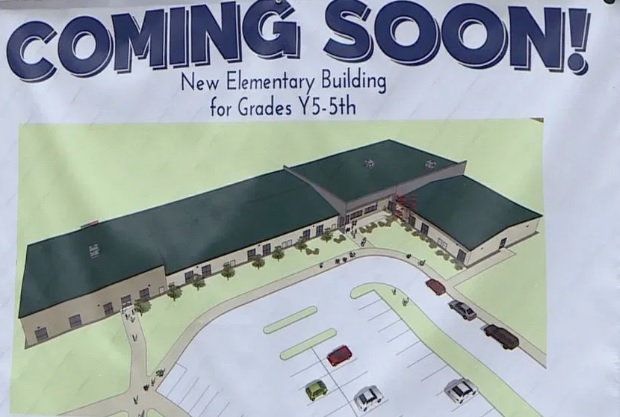

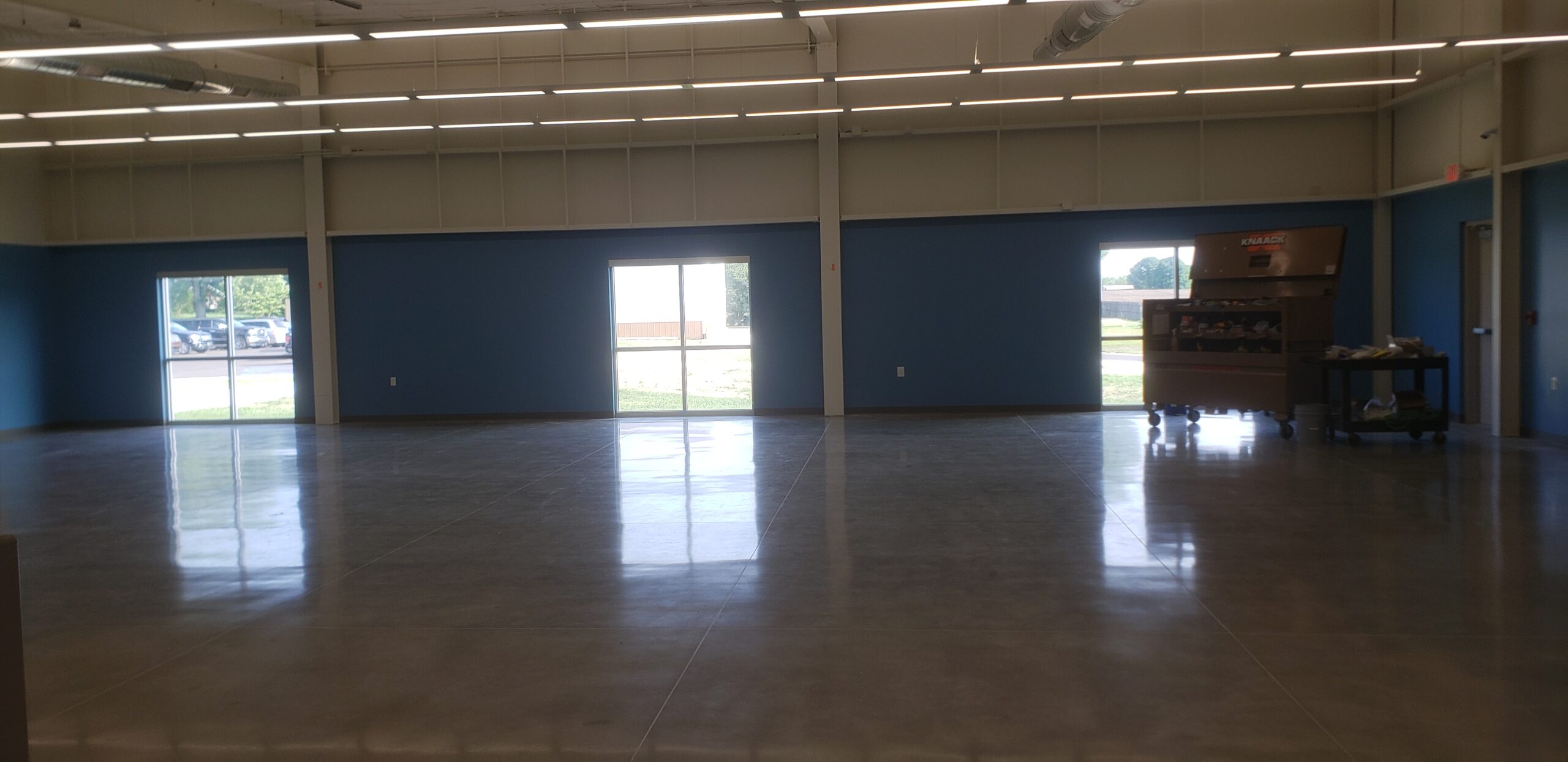
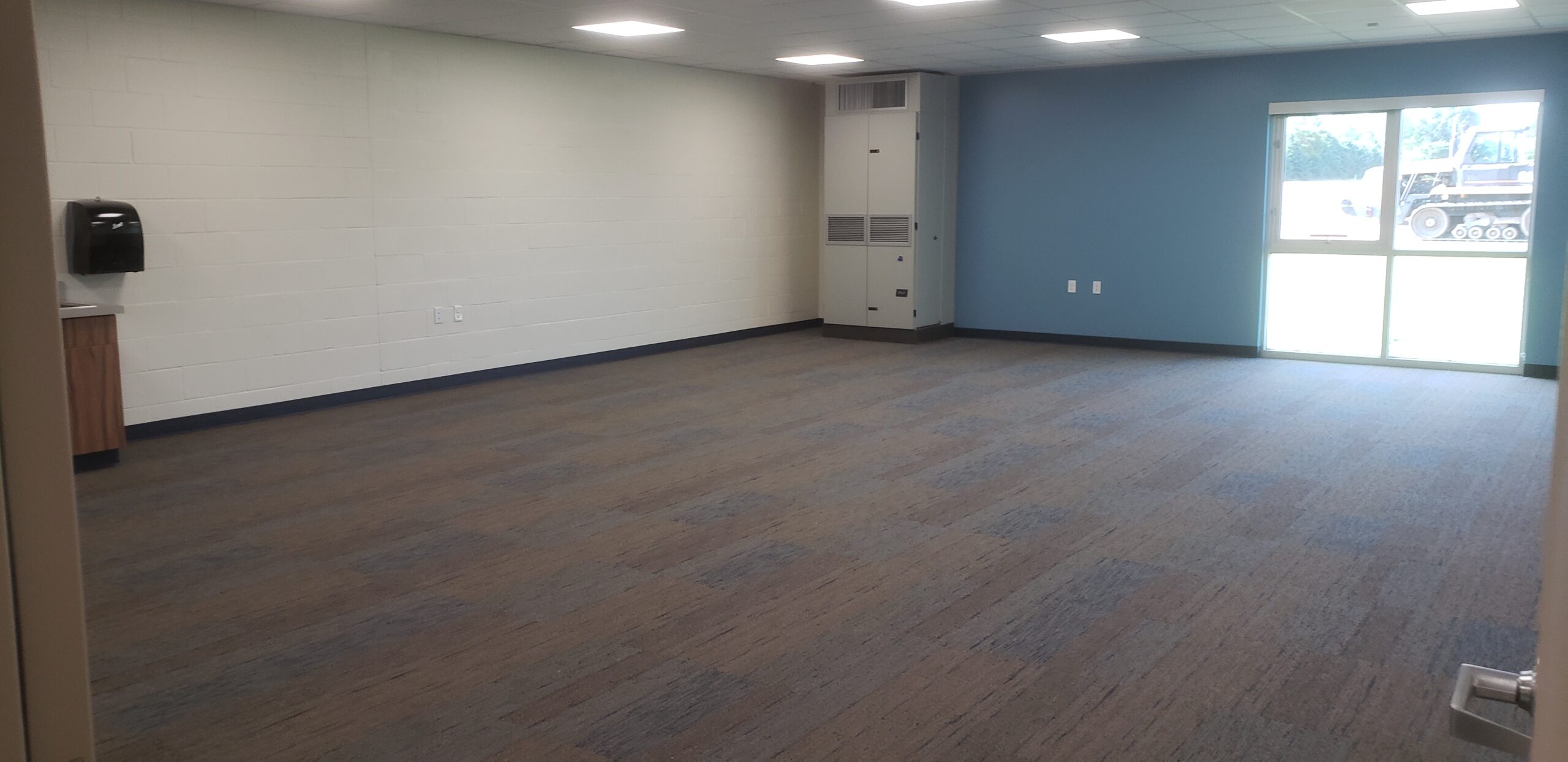
What Are Charter Schools?
Charter schools are schools that operate outside of the traditional “School District” formula. Charter schools exist to give a choice to parents and to provide different educational experiences for children.
Charter schools do not receive any funding outside of the per pupil base allowance that each school receives, currently 9,150 per student. They do not receive any operating millage tax dollars, nor do they receive any property tax dollars for things like buildings and facilities.
44 states have charter schools, and of those only 14 do not have a mechanism to assist charter schools with building costs, Michigan is one of them.
The Founding of Countryside:
When the Charter school law passed in 1994 a group of 6 farmers met to discuss the idea of starting an agriculture based school in the area. Just starting a school is no easy feat. Countryside purchased the land in the fall of 1995 for $61,800. In order to get off the ground the school had to be approved to receive per pupil funding, which originally was denied. From my limited legal understanding this had little to do with Countryside itself, and was about Benton Harbor Schools being able to fulfill it’s responsibilities from earlier court orders to desegregate students from the 1970s and 1980s. The idea was that Countryside opening in a rural area in the district could negatively impact Benton Harbor’s ability to meet it’s obligations. (Court Docs here)
“In March 1996, the State petitioned this court to allow state school aid funding to be paid to Countryside Charter School, the first charter school attempting to open in the Benton Harbor School District (docket # 1006). Following review of the potential impact on the remedial order, the court denied that funding (docket # 1013). In April 1997, the State again petitioned the court to allow funding of Countryside (docket # 1076). Based on certain changes in the composition of the board, the students recruited, the specialized curriculum and certain assurances made by Countryside, together with annual reporting, the court permitted the funding of Countryside (docket # 1079).”
In the fall of 1997 Countryside opened with 194 students in a 5 classroom modular building surrounded by farmland. Countryside is chartered through Central Michigan University. Even such a modest facility came with significant cost.
Think about the cost to install multiple trailers with electricity, heat, water, and septic. Think about the cost of the land. Think about the cost to furnish it with desks, chairs, books, computers. Think about the cost to hire the teachers months before the state pays for the head count. Starting a school is an extremely costly endeavor and this was done by a small group of farmers with limited resources. I have no doubt that it took hundreds of thousands of dollars at risk to get the school started.
This wasn’t like Lebron James starting a school, where resources are effectively unlimited. No shade to Lebron, what he did in starting a school was a great thing for the kids, but the challenges he faced were vastly different than the challenges these founders faced on an economic level.
In 2002 when Countryside graduated its first seniors, President George McManus said:
“We wanted something in the country because we’re all from the country and we raised our kids in the country and we wanted our kids educated out here….There’s a lot of criticism amongst schools run by corporations, but we’re not (corporate-run),” McManus said. “We’re just put together by parents.”
80% of Michigan Charter schools are operated by for profit management firms, Countryside is a non profit.
Location:
The location is key. Countryside Academy is located near the convergence of 4 school districts, and is roughly an equal distance from all of those districts high schools. Countryside pulls primarily from the Benton Harbor area, however many students do come from the Coloma, Watervliet, and Eau Claire school districts. Countryside also serves many migrant farming students.
- Benton Harbor High School: 7.1 Miles 14 minutes
- Coloma High School: 8.5 Miles, 14 minutes
- Eau Claire High School: 8.6 Miles, 13 minutes
- Watervliet High School 12.3 Miles 19 minutes
86% of Countryside students qualify for free or reduced lunch. 51% of the students are Black, 35% Hispanic or Latino, 10% White, and 3% Multi-racial.
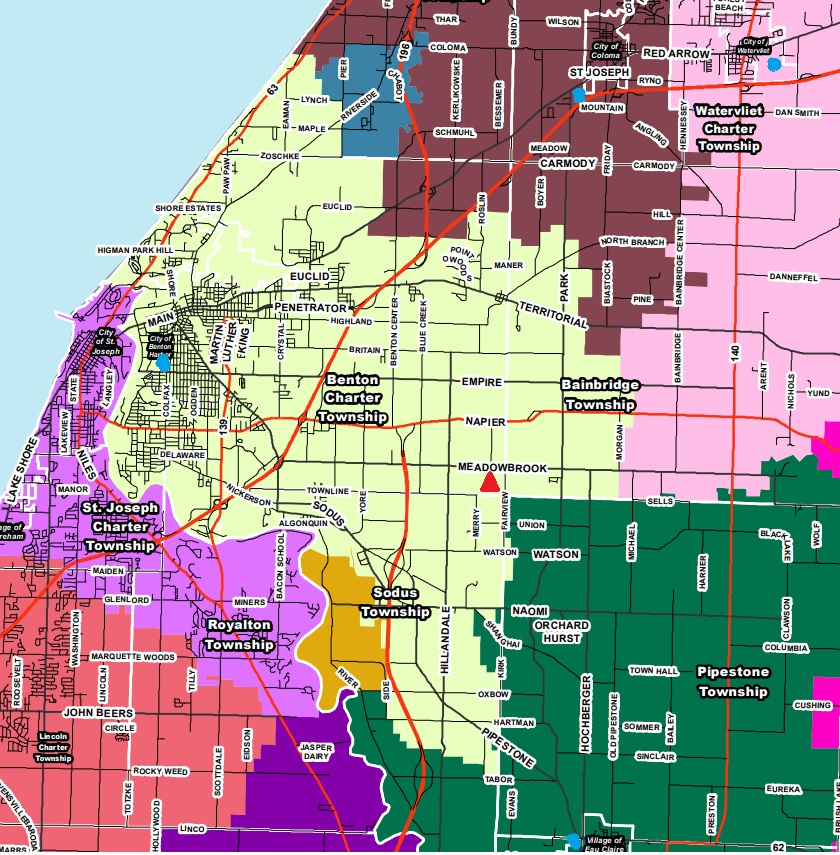
The boundaries are the school districts. The red triangle is Countryside’s location. The blue dots are the 4 high schools of the other surrounding school districts
The Growth of Countryside:
- 1997: Countryside started with 194 students in 1997 as a K-8 school. Each year they added another grade to allow the kids already in the system to move up. Countryside opened in a series of attached modular buildings that are still in use today. This is a 13,000 square foot building with 8 classrooms and restrooms. I believe there are a total of 10 modular units that make up the original school.
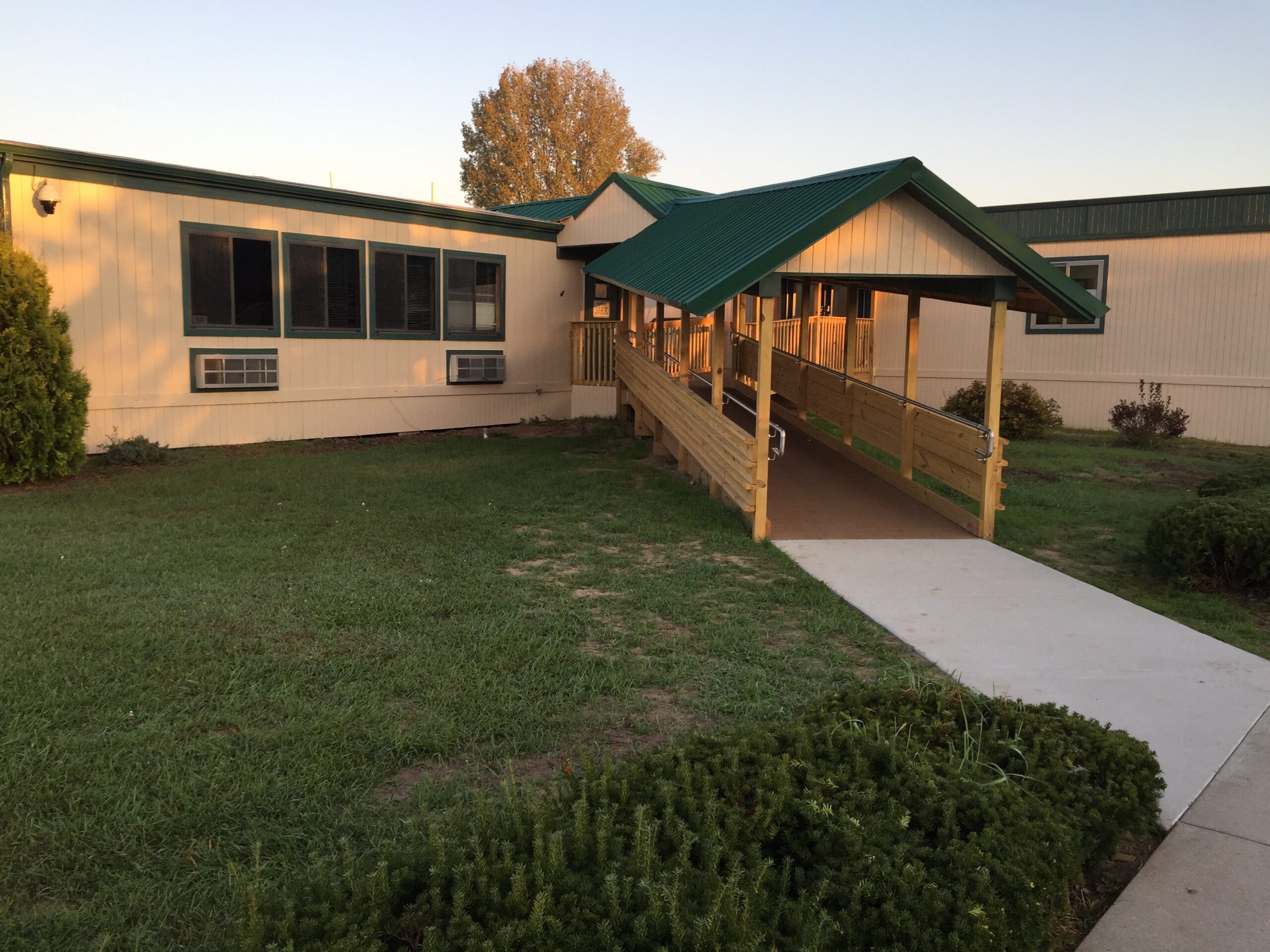
- 1999: Constructed the East wing of the permanent school building on the same land as the original building. The East wing cost $1.6 million and contains 10 classrooms, an art room, a multi-purpose room/ gym, and a lab.

- 2000: Constructed the West wing of the permanent school building. The East wing and West wing combined total just under 40,000 square feet and have 22 classrooms. I could not find a source for the price of this wing, however with it being smaller (no gym or lab) roughly 15,000 sq ft vs 25,000 sq. ft. and with it being constructed so close in time to the East Wing, I would guess that the cost was somewhere around $1 million to $1.3 million.
- 2003: Total enrollment exceeds 500 students
- 2004: Added the Aviation building. This building is 6,000 square feet and is used for Countryside’s unique aviation program. With this building being much smaller and simpler (not “finished” space”) I would guess the price tag to be somewhere in the $100,000 to $200,000 range.

- 2005: Spent $1.5 Million renovating the Millburg school, and opened it up as the early learning center with 9 classrooms and capacity for 200 students.

- 2012: Added a 12,000 sq ft gym (Located behind the main school) at a cost of $600,000.
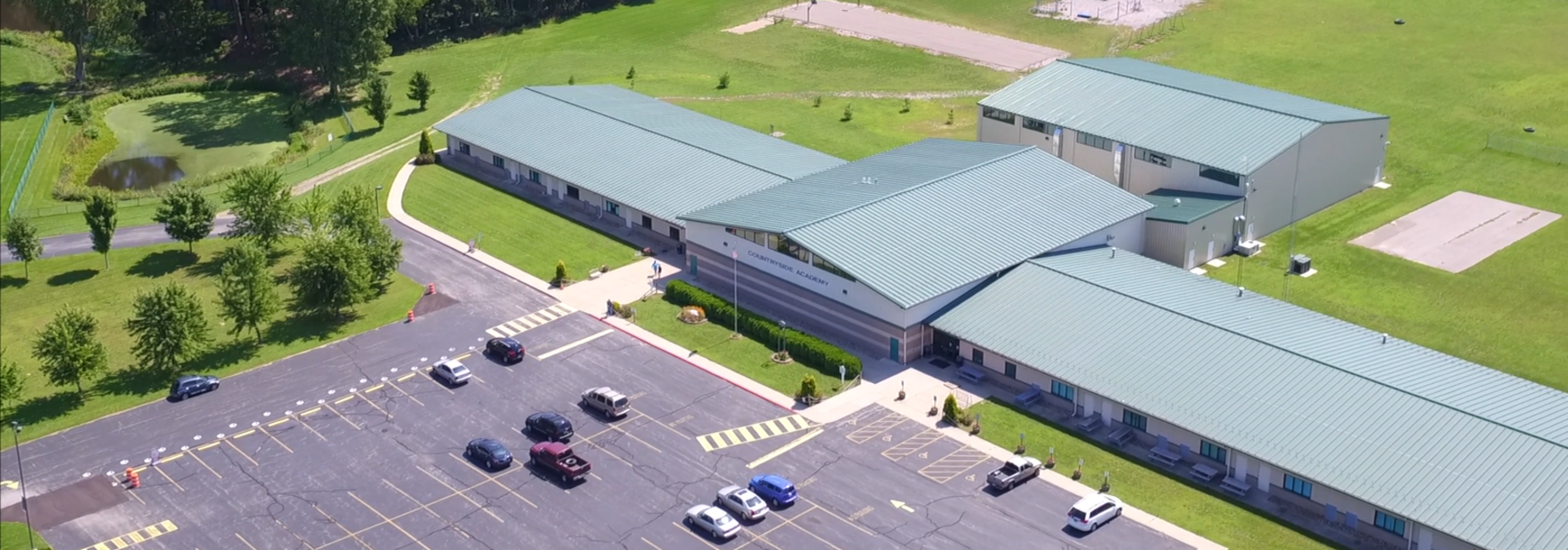 2018: Added the 60 X 80 barn, a science classroom, green house, and conference center at a cost of $1.7 million. Total enrollment reaches 750 students.
2018: Added the 60 X 80 barn, a science classroom, green house, and conference center at a cost of $1.7 million. Total enrollment reaches 750 students.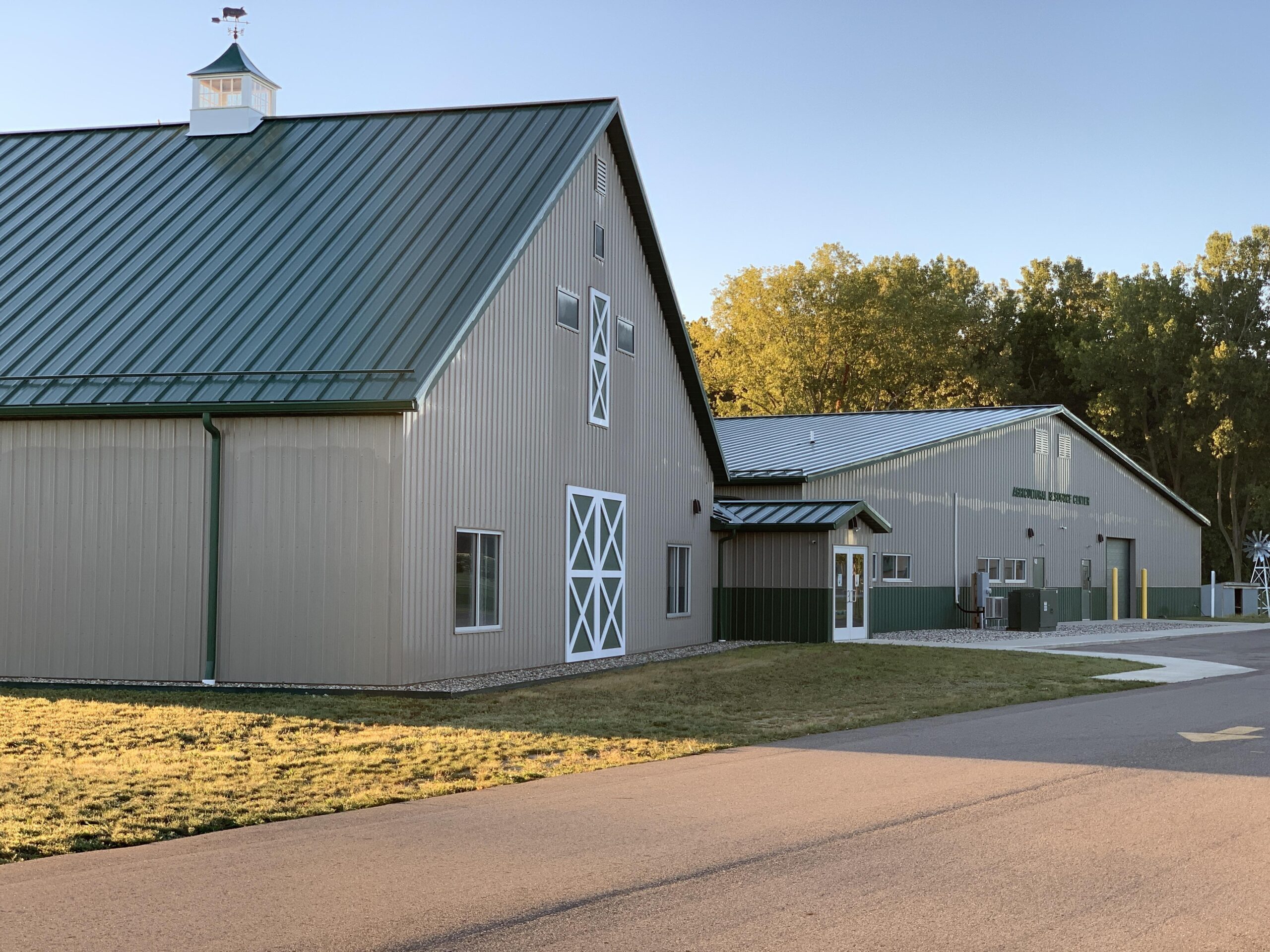
- 2024: Opened the new 37,000 sq. ft Early learning center with 19 classrooms. Sold the Millburg building with its 9 classrooms. This move allows all Countryside students to be on the same campus. This project really started in 2022 with the acquisition of the 40 acre parcel next to the school, which came with a house. Countryside subdivided off the house, sold it, and kept the land for this addition. I was unable to find the data on the purchase price of the property, however the house sold for $345,000. My assumption is that the 37 acres Countryside retained was extremely inexpensive.

Here’s a video overview of Countryside from 2015:
What Makes It Different:
Countryside Academy is FARE based, which stands for Food, Agriculture, Renewable Resources, and Environmental. The idea isn’t to turn all the kids into farmers, but to use the concepts of farming and agriculture to enhance other subjects and to give the kids a connection to the land.
Kids at Countryside:
- Plant gardens
- Raise chickens
- Raise and release salmon
- Make maple syrup
- Raise goats and pigs
- Perform 40 hours of community service as a requirement for graduation
- Have an aviation program. Check out this video from Moody on The Market
Board President and one of the founders of Countryside George McManus said at the opening of the new Elementary school:
“If we were simply a carbon copy of other schools, why would we be needed? Look around our campus – hammocks in the yard, picnic tables by the pond? A barn with animals? A nature trail? Who does that? We do it,”
Also what schools are on 100+ acres?
Recent studies have shown that 25% of charter schools close in 5 years and 50% close within 15. Countryside is pushing 30 years now. A big reason for these closures is that there is no mechanism for funding the buildings like there is for traditional school systems. Traditional school systems will also magically stay afloat from tax payer bailouts when they fail, unlike charter schools.

The red box on the left is the new elementary building. The red box on the top right is the ARC barn building. The original modular building is the white roof building closest to the road. The main building is the green roofed building in the middle and the gym is the south most building attached to the main building.
Financials:
Unfortunately the financial year ends on June 30th, so the statements I have to look at are from the most recently completed year, which ended 11 months ago.
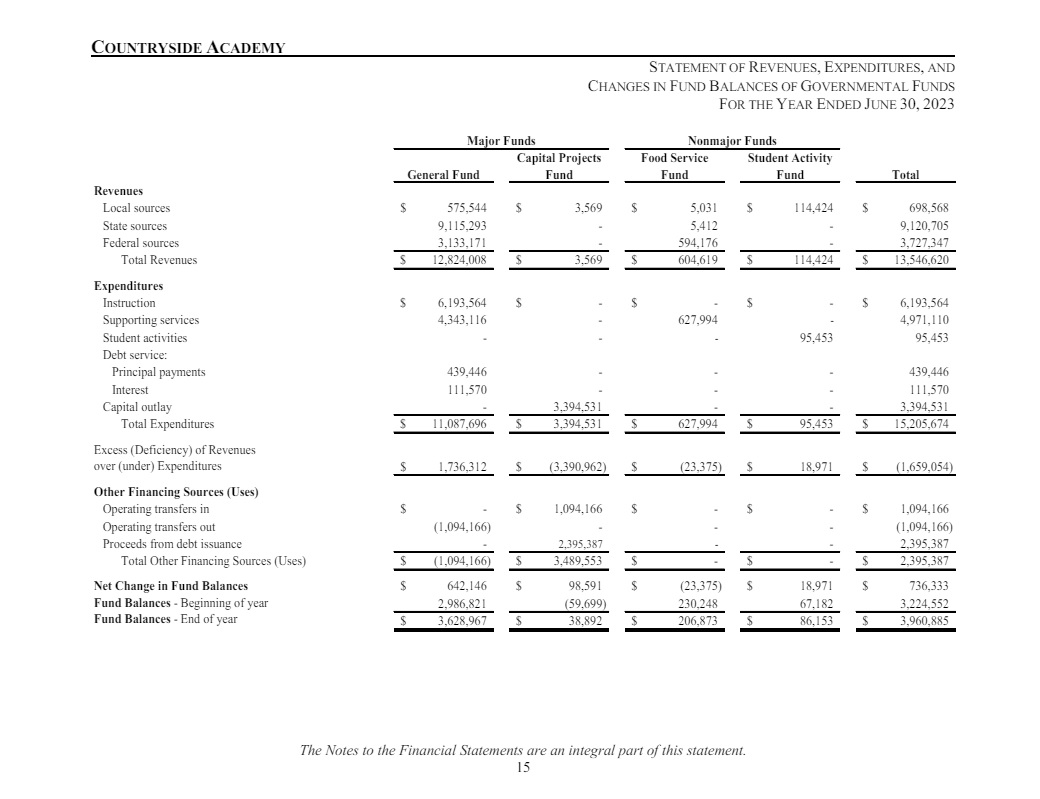
The school had total Revenues of $12.8 Million and spent $11.1 Million, giving a surplus of $1.7 million or 13.2%. It is important to note that the total expenditures includes $440,000 of principal repayment on debt, which is added to the schools long term equity position. The school only paid out $112,000 in interest, which is very low for a school of this size.
Of the $1.7 million surplus, $1.1 million was transferred to the Capital projects fund, which was building the new elementary building. At the time of this statement $3.4 million was incurred for the new build, and the school had $2.4 million of new debt issued. The school has $3.6 million in its general fund currently.
It will be interesting to see the financial statements for this fiscal year which will show the building being complete, as well as next years which will show the revenue generated by the new building. With interest rates as high as they are I would expect that Countryside will be making early payments on the debt for this building.
Countryside, unlike some corporate run charter schools is extremely financially transparent. Budgets, audited financial statements, personnel expenditures, and checkbook registers are all published on their website.
The Future:
Enrollment:
Countryside will certainly expand enrollment with this new school. Although the Administration spoke of an increased capacity of 50 students with this new building, I believe that the increased capacity is much more. On the main campus excluding the modular buildings, Countryside now has 41 classrooms. At an average head count of 25 each, this would put total capacity at 1,025 students.
One of these classrooms is also double sized and for the new pre-school program. I think this will add another 20 students, so now we are at 1,045 total capacity right off the bat. The preschool program, which very few districts offer, will allow Countryside to have a major competitive advantage with recruitment of new students who will then spend another 13 years in the system.
If they choose to retain the 8 classroom modular buildings, this is capacity of another 160 students, for total capacity of 1,205 students.
I think it is highly likely that starting with the 2024 school year Countryside will see total enrollment of around 900 students. I am estimating 45 for the new pre-k program, and 4 net new classes of 25 each. My estimates have no inside knowledge and are much higher than what the school has predicted.
What I will say is that when Countryside built their original Elementary wing for the permanent building in 1999 their enrollment increased by 121 students, from 259 in 1998 to 380 in 1999.
Sports:
With a growing enrollment and more high school kids, Countryside will be able to offer more sports programs. One planned item for the new school addition was to also install an Airdome for a covered sports field. This was tabled over the course of the last year, but I think is likely to come back into the discussion.
More sports offerings will bring more students, and having more students allows the school to offer more sports. My 2 kids remaining in the school system are looking forward to playing basketball, football, and track.
Compared to Benton Harbor:
One of the main reasons Charter Schools exist is to provide an alternative for students otherwise trapped in a failing school district. Benton Harbor Schools have been failing for decades. By every measure you can find Benton Harbor has under performed. They spend more per student, they have extremely low grade proficiency rates, low graduation rates, and higher crime rates.
Revenue:
In 2022 Benton Harbor received $31,155 per student, while Countryside received $17,013 per student. For the school year ended in 2023 Benton Harbor received $9.1 million in Property tax revenue, $5.6 Million in Unrestricted state revenue, and $31.9 Million from “Operating grants and contributions”.
Benton Harbor has been a large beneficiary of recent government spending. In November of 2023 the state of Michigan “forgave” $10 million of Benton Harbor School District’s debt. Benton Harbor Area Schools also received over $36 million in Covid relief funds between 2021 and 2024.
Benton Harbor schools will likely start seeing much higher property tax revenues. The $85 Million Whirlpool headquarters will start paying taxes this year and new construction Harbor Shores houses are starting to pay property taxes as well. There is also the $22 million Whirlpool apartment building that should be paying taxes as well. The Benton Harbor assessment office has also been extremely aggressive with re-assessments at property sales. As an anecdotal reference I paid $35,000 for a house, which was market rate, and the city stated this house was worth over $86,000. This more than doubled the taxable value from when I purchased it. Vacant lots have also seen massive increases in their assessments, with most having their assed value increasing from $400 to $2,800.
Read more on “Are Poor Urban School District’s Really Underfunded?”
Enrollment:
Over the last 22 years Benton Harbor’s enrollment has declined by 75% from 5,127 in 2002 to 1,292 in 2024. I used the last 22 years because my primary source (MI School Data) only goes back to 2002. I did find this article that shows Benton Harbor had 6,611 students in 1998. This is an 80% decline in the 26 years since 1998 and a total loss of 5,319 students.
In 1999 Benton Harbor Superintendent Renee Williams said “We know that we’re down, and we’re having to find out where the loss is at.”
Last week in 2024, Board President Dashuna Robinson said “The district needs to find out why the students left so they can figure out how to bring them back.”
It’s been 25 years and they are asking the same questions.
Benton Harbor schools are still on a deep decline in enrollment.
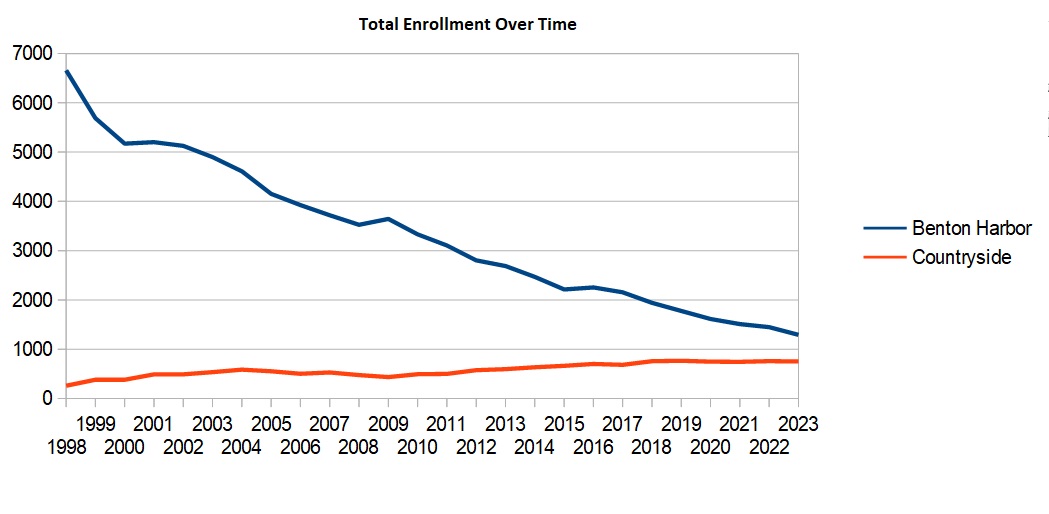
Benton Harbor will lose enrollment just based on the number of kids currently in each grade, and this makes sense. Families that were already in the system may have chosen to stay in the Benton Harbor school system, but more new families without children in a school system have been choosing to never start their kids in Benton Harbor, so Benton Harbor has been losing through this gradual attrition. We are an example of that. When our oldest was 5 we started him in Countryside, despite the transportation being much more difficult. This was 2008 and we were very low income and we lived in the Benton Harbor School District. Subsequently all of our kids have gone to Countryside.
| Grade | Total Students | Per grade | |
| High School and Career Center | 9 to 12 | 557 | 139.25 |
| Fair Plain Middle | 6 – 8 | 249 | 83 |
| Fair Plain East | 4 – 5 | 166 | 83 |
| MLK | 1 to 3 | 234 | 78 |
| Discovery | K | 86 | 86 |
Looking at this chart we see that the average students per grade for the high school is about 56 more students than for all other grades. This shows that in the next 4 years, we should see the total enrollment in Benton Harbor Schools decrease by around 224 students without any families choosing to take their kids elsewhere. This will drop them to 1,068 by the 2027 school year. If instead we follow the recent trend of around an 8% loss per year, by 2027 it is likely that Benton Harbor enrollment will drop to 925 students.
Countryside enrollment has remained stable at right around 750 for the last 6 years. This is due to reaching capacity for existing classrooms. Countryside has a large waiting list and it will be interesting to see what the total enrollment ends up being for the 2024 school year with the added capacity of the new building. I would expect for total enrollment to exceed 800 and possibly reach 900.
Countryside is just 1 small location of where some of the Benton Harbor students have been going. There are a couple other Charter schools in the area that combined have enrollment similar to Countryside’s. School of choice has allowed students to go to other schools in the county. Countryside had 490 students when Benton Harbor had 5,127 students in 2002. Since then Benton Harbor has lost 3,835 students while Countryside has gained 262.
Currently 3,420 students that live in the Benton Harbor school district attend schools other than Benton Harbor.
Academic Results:
The 4 year graduation rate:
- Benton Harbor: 56%
- Countryside: 82%
- State of MI Average: 82%
On Track Attendance:
- Benton Harbor: 14%
- Countryside: 70%
- State of MI: 68%
Expenditures Per Pupil:
- Benton Harbor: 17,329
- Countryside: 10,316
- State of MI Avg: 13,168
Suspension / Expulsion:
- Benton Harbor 261 (506 high school students)
- Countryside 31 (372 high school students)
Proficiency or Advanced on State Testing
- Benton Harbor: <5%
- Countryside: 19%
- State Average: 37%
Why do families leave Benton Harbor schools? Because they don’t think their children will be safe there. Because they don’t think their children will learn there. Because they don’t think the school system will make wise decisions with their children, with their teachers, and with their resources. Benton Harbor Area schools needs to prove otherwise.
Positives For Benton Harbor:
Benton Harbor now has far fewer students than it historically had, while at the same time it is receiving unprecedented revenues (Covid relief funds, debt forgiveness, and increased property tax revenues). Benton Harbor Area Schools should have more than enough resources to now give the kids they do have the attention needed to ensure they are successful. With fewer total students it is also easier to identify and correct those who need extra help and those who are the trouble makers.
I think Benton Harbor could strongly pursue having job skill training. They have lots of space to have programs like this in place. If Benton Harbor offered programs where kids could graduate high school with job placement already in place for them for high demand careers like Welding, Electrical, Plumbing, Nursing, and Data Analytics they could reverse the trend and be the school that parents decide to send their children to for these programs that give their children something they can not get in another district. (By the way I think EVERY school should be doing this.) We used to do this. It was common up until the 70s for schools to have vocational programs that led to job placement in skilled trades right out of high school. If parents knew that their child would be graduating high school with a job lined up where they will be earning $45,000 – $60,000 a year right out of high school…game changer. (Countryside should do this too, but doesn’t have the resources, space and money for it currently. BHAS does. Perhaps in a couple more years)
Benton Harbor Area School Districts also has significant real estate assets. Currently they have over a half dozen boarded up school buildings that are not in use. They have the opportunity to put some of these buildings to use, or to sell them to further strengthen the balance sheet. A great opportunity would be to rent out one of their former schools to the DHS. The DHS is currently paying $1.8 million per year to rent a 75,000 square foot office space, when they only need 20,000. They are currently looking for a new location. The Hull Academy school in Benton Township is roughly 50,000 square feet and would lend itself to being a DHS office very well. The school district could rent this building out to the DHS for 1/3 of the cost and it would be a significant win for the district.
Fixing Charter School Funding:
Property Tax Mechanism For Charter Schools:
Currently the way the school system works is primarily through property taxes.
- There is a 6 mill levy on all property in the state assessed on summer taxes. This levy goes directly to the state of Michigan and then gets disbursed as part of the per pupil funding to all schools. Regular school districts and charter schools receive this per pupil funding, which is currently $9,150 per student per year.
- School districts can levy an 18 mill property tax on all non-homesteaded property in the district for general operating purposes. This is levied on all businesses, 2nd homes, and rental properties. 100% of this revenue goes directly to the school district. An 18 Mill levy in Michigan on a property with a market value of $100,000 is $900 per year.
- School districts can have special elections for additional property tax levies. This is often done for adding on to existing schools, major repairs, or things like new gyms. The people in the school district can vote “Yes” or “No” to approve the levy.
An understanding of this funding mechanism should put to rest the argument that Charter schools are unfair competition to traditional school systems. The traditional school systems have historically held a government mandated monopoly on education, with their customers (students) being forced to buy their product (attend school with compulsory education laws), and continue to have a monopoly on the ownership of everyone’s property in the district (sole ability to levy 18 mill property tax). Traditional schools, even when they lose out on the per pupil funding from students leaving for Charter schools, private schools, online schools, or school of choice, are still heavily funded.
Changing Charter School Funding For Buildings
Item 1:
The 18 mill levy should be proportionally distributed to the schools in the district based on their student count. For example. Benton Harbor Schools currently 1,292 students out of a total of 4,712 students who live in the district. Benton Harbor should only receive 27% of the revenue from this millage.
- Benton Harbor 1,292 27%
- Countryside Academy 500 (estimated 500 / 750 are from Benton Harbor District) 11%
- Benton Harbor Charter 455 10%
- Mildred C Wells 215 5%
- Bridge 121 2.5%
The rest of the funds should go wherever the students are, they should follow the student the same way the base $9,150 does. Why should Benton Harbor Area schools receive 100% of a millage designated specifically to educate the K-12 children in the district, while Benton Harbor only educates 27% of the children in the district? It doesn’t make any sense.
Item 2:
Charter Schools should be able to put a vote out for a property tax levy to support them for infrastructure costs the same way the traditional school districts do. For example, to build the recent building, Countryside Academy could have asked to voters of the Benton Harbor school district “Will you approve a $8 million property tax levy to build this school with 19 class rooms?” If the majority vote yes, then it passes, if not, they are back to what they did here by self financing through operating dollars.
The Charter Schools would need to make the case for voters WHY they should support them. Now Countryside is only educating a small portion of the district, so it is possible with that low of a percentage they would not get enough support to pass a ballot measure, however it is possible that they provide a proposal that is fiscally conservative and has a great business case for the community that it will be approved. It would be up to the voters. They should have the ability to have a request on the ballot.
There could be some guard rails in place, like they can only ask for a millage of up to a certain limit, maybe 2 mills maximum for no more than 10 years. This would be a cost for a property worth $100,000 of $50 a year.
Item 3:
If neither of the above changes took place, I think this would be the best mechanism: Follow what Indiana does. An area where other states have been successful in is providing a per pupil facilities allowance to charter schools. With this mechanism, rather than the school just receiving $9,150 for each pupil for operating costs, they would receive an additional amount per pupil for a facilities allowance. For neighboring Indiana, that number is $667 per pupil.
For Countryside with 752 students this would be $501,000 PER YEAR. This would be a massive game changer.
Item 4:
MAPSA, Michigan’s Charter School Association has 2 legislative ideas for school building access for charter schools:
- Requiring access to existing public school buildings by any entity approved to be a
public school. - Opposing the arbitrary demolition of existing public school buildings when another
educational entity indicates their intent to use that facility.
It is disheartening to see failing public school systems, especially those deeply in debt, like Benton Harbor was up until last year’s gift of taxpayer money, board up unused schools rather than sell them, and allow these schools that taxpayers paid for to fall into disrepair and eventually be bulldozed. Benton Harbor has I believe 15 school buildings and uses 6 of them. The school districts should be forced to either put these buildings to positive economic use, sell them, or give them to state approved charter schools.
This isn’t about The District’s money. This is about taxpayer money. Of the 3,400 kids in district not going to the District school system, over 1,500 are going to Charter schools and the taxpayers of the district paid for those buildings. Those buildings should be made available to the children of the district.
The fact that Countryside has been able to continually expand its facilities to make the education experience better for the children and parents in the community without property tax support is a major testament to how the school is ran, with common sense and fiscal conservatism.
What do you think of Countryside, of Benton Harbor, and of these ideas for shifting our tax mechanism?

Leave a Reply